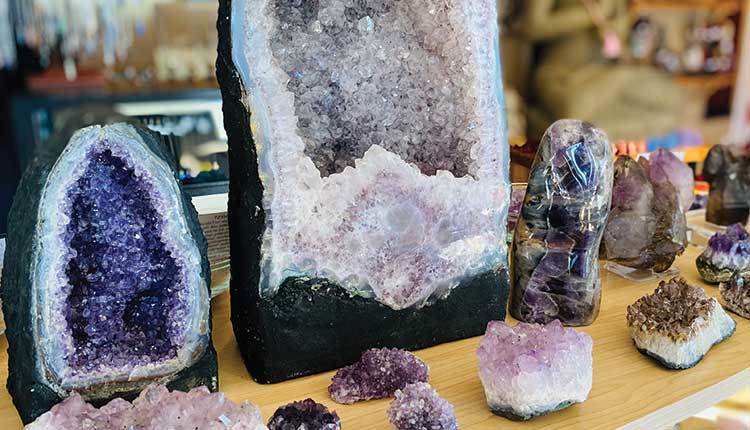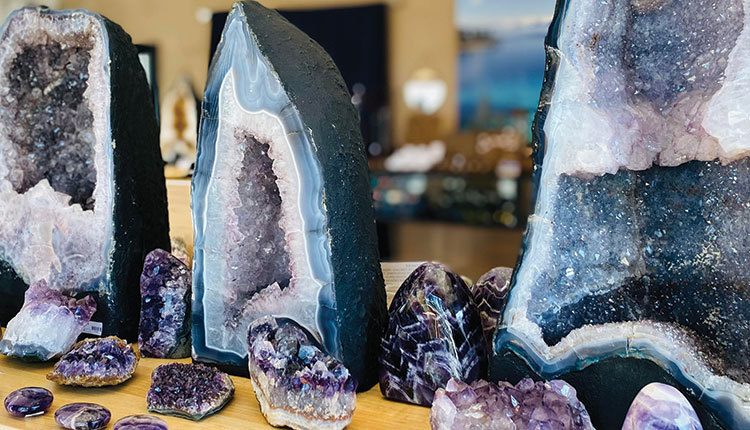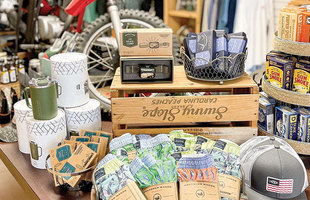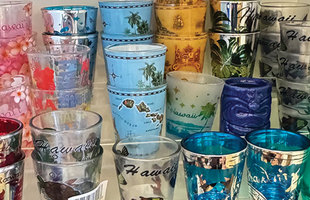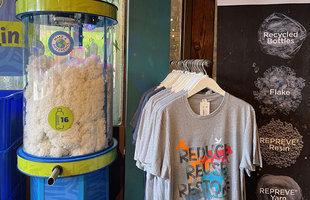The fact that rocks, gems, crystals and other specimens are being discussed as mainstream gifts and souvenirs means they have come a long way, says Jeremy Stiles, owner of Mountain’s Edge Rocks & Minerals in Divide, Colorado.
“Awareness to minerals is growing constantly,” he says. Ten years ago, the lifetime rock hound explains, many businesses that would not want to sell a mineral if it had any metaphysical aspects to it, but attitudes toward these minerals have changed.
These days, those metaphysical properties are what attract buyers to the most popular natural beauties, such as tourmaline, quartz, amethyst and citrine, Stiles notes.
“It is a gift that literally will last as long as you keep it,” he points out.
So just exactly how does one display these earthly wonders to attract the most attention? Stiles believes the secret is in showing off their sparkle — which begins with good lighting.
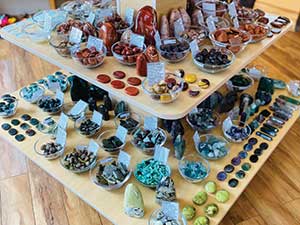
Well Being Massage and Gift Shop in Kings Beach, California, uses wood shelves instead of glass shelves to organize gems.
Shine a light “If you have a room that’s well lit, but it doesn’t have directional hotspot-type lighting, like a real focused beam, you don’t get the glitz, you don’t get the shine where your eyes are drawn to certain areas,” Stiles says. “Sometimes when I’m not sure and I’m only buying one, I’ll back up and I’ll say ‘which one sparkles the most?’ Because, frankly, it’s what people are drawn to.”
Stiles points to amethyst as the number-one bestselling mineral for destination retailers to put their money into for a multitude of reasons.
“It’s the most purchased crystal across the board,” he asserts. “It’s something that people are familiar with and they love the vibrant color.”
Labels make a difference
At Coos Canyon Gift Shop in Byron, Maine, Owner Rosey Susbury agrees amethyst is one of the most sought-after minerals. However, she says, she has also found another secret to displaying crystals — labeling them.
“People don’t want to just pick up a pretty rock,” she explains. “They want to know the story behind it.”
Susbury says taking the time to explain where specimens were found and what they’re known for provides a bit of history that makes it even more valuable in the customer’s mind.
“When you attach what a stone is, what its metaphysical properties are, or how it can enhance your space — like bringing calmness or stress relief — people are very interested in that,” she notes.
Less is more
Across the country in Kings Beach, California, Well Being Massage and Gift Shop Owner Sarah Hughes has a straightforward philosophy on displaying rocks, tumbled stones and crystals — keep it simple.
Hughes notes after spending time in numerous “new-age shops” in nearby Sedona, Arizona, she realized what worked and what didn’t. Using three-tier displays and wall shelves, Hughes likes to keep the room open and encourages others to do the same.
“It just it just creates a nice earthy feeling when you come into our store,” says Hughes, who owns the gift shop and massage space with her husband, Nick. “Our store’s light, but it’s grounded as well.”
Simple shelving
In particular, Hughes notes, shelving and organization play a huge role in displaying gems and crystals. For this reason, she chooses wood shelves over glass and clear glass bowls over colored ones.
“Less is more I always say. Don’t overcrowd the space,” she says. “I don’t know anything about feng shui, but I always feel like our store is set up well, in that sense, because I always feel like the energy flows. Nothing’s blocked so you can physically get around.”
She adds that making the shopping experience “as pleasant as possible” through soothing music, a comfortable temperature, and most important — a deliciously scented space — also makes all the difference.
“The one No. 1 thing customers comment on is how good it smells in here,” she says. “We don’t have strong smells, not like strong perfume smells. It’s always just more natural kind of smells.”
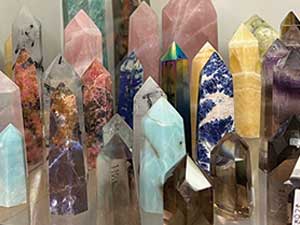
At Coos Canyon Gift Shop in Byron, Maine, one key to displaying crystals is clearly labeling them.
To show off the best she has to offer at Coos Canyon Gift Shop, Susbury also keeps it simple with open shelves, baskets and showcases for higher-end pieces. And nothing helps more than by grouping materials together — both by size and type.
“You don’t want to have to run between all the customers in the store saying, ‘excuse me, I need to get this,’” she says. “You just want to be able to take them to the one area or two areas and show them what you have.”
A natural interest
Susbury, who began her rock gift shop more than 33 years ago with her mother, Mary, says a deeper interest in rocks, gems and crystals is something that came around during COVID. She attributes their shift in popularity to a desire to connect with nature.
“People had a lot of time at home, learning about rocks and what they can do for you,” she explains. “I feel like more people are buying the rocks to enhance their space, whereas before it might have been a knickknack.”
Not that natural connections are hard to find in her neck of the woods. Susbury, whose shop is located across from the Coos Canyon rest area, notes the area is rich in gems and minerals, such as blue aquamarine, pink morganite, amethyst, quartz, gold and tourmaline.
Another service Coos Canyon Gift Shop offers related to rocks and minerals is gold prospecting. Susbury rents out equipment to people who want to try their luck panning for gold in the Swift River which runs behind the gift shop.
She also sells gold from locals who mine the river regularly.
Advice for the wiser

Well Being Massage and Gift Shop uses three-tier displays and wall shelves for rocks and crystals.
When it comes to pricing rocks, gems and crystals, Stiles says to expect a two-and-a-half- time markup, which is a 60% gross profit.
“If you can’t sell for that then you shouldn’t buy it,” he cautions. “There are no two rocks that are the same, so no one really knows how to value that one rock. So, it’s really a matter of what your consumer likes and what they can afford. That is the only thing that controls the price.”
To really develop an appreciation for a crystal, Hughes includes a laminated card that describes its properties.
For this reason, Hughes also suggests that labels be typed and not handwritten notes. Instead, take the time to list the properties of a rock or crystal — even if you have 144 different types.
“It’s really good to have everything neat, so it’s not all just hand-scribbled notes all over the place,” explains Hughes.
Susbury says those who are interested in rocks, gems and crystals should continue to educate themselves, as new products are always coming into the market.
Stiles says he advises avoiding direct sunlight whenever possible — especially with big show pieces that are used to draw attention.
“With any crystal, or anything that’s translucent, like citrine, if it’s exposed to direct sunlight, like if you leave it in the window for a month or two, you won’t notice it,” he says. “But in a year, if you’ve taken a picture, you will notice the color fades eventually.”
In other words, not all light is created equal when trying to capture a specimen’s inner sparkle. So be sure to choose wisely.
